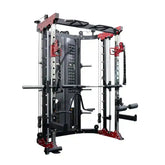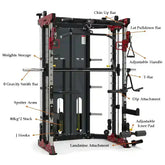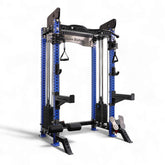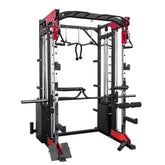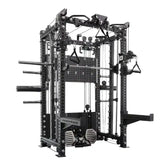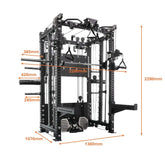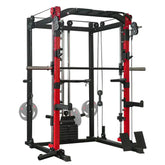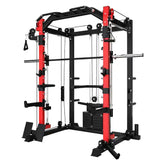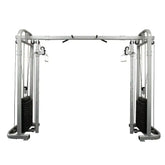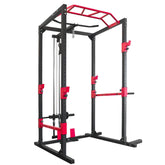Progressive Overload Training with Dumbbells: The Science of Strength Gains
Progressive overload with heavy dumbbells is one of the most effective and proven methods for building lasting muscle, strength, and definition — whether you train in a commercial gym or from your home setup.
Learn how to use heavy dumbbells and progressive overload to build strength and muscle consistently — no machines required.
When I first stepped into a gym, I thought training harder meant training longer — endless sets, endless sweat. But after a decade of coaching athletes, bodybuilders, and everyday lifters, I’ve learned something far more powerful:
“You don’t grow from doing more — you grow from doing better.”
That’s what progressive overload is truly about — training smarter, not just harder.
It’s not about punishing your muscles daily. It’s about gradually increasing challenge and intensity so your body adapts, grows, and becomes stronger.
This approach completely transformed my own physique when I was competing — and it’s the same system I now use with every client, whether they train with a full commercial setup or a home gym dumbbell set.

What Is Progressive Overload?
Progressive overload is the gradual increase of stress placed on the muscles over time. It’s how your body adapts — by growing stronger, denser, and more efficient after every workout.
You can overload your muscles by increasing:
-
Weight — heavier dumbbells.
-
Reps — more work per set.
-
Sets — higher volume.
-
Time under tension — slower reps.
-
Training frequency — more sessions per week.
When you combine these principles strategically, your muscles are forced to rebuild stronger every time.
Why Dumbbells Are Perfect for Overload Training
Barbells and machines are great — but dumbbells create a more natural, balanced movement pattern. They train stabilisers, coordination, and control, which makes overload even more effective.
Using heavy dumbbells also teaches symmetry. Each arm and leg must work independently — no side dominates, no cheating.
That’s why all my programs, from athletes to physique competitors, start with dumbbell variations before moving to compound barbell lifts.
The Science Behind Muscle Growth
Three mechanisms trigger muscle growth (hypertrophy):
-
Mechanical tension – lifting heavy loads through the full range.
-
Metabolic stress – generating fatigue, the “burn.”
-
Muscle damage – small fibre tears that rebuild stronger.
Progressive overload targets all three over time.
For example, increasing the dumbbells from 20kg to 25kg in your dumbbell bench press adds mechanical tension. Slowing your tempo from 2 seconds to 4 seconds increases metabolic stress. Both lead to measurable growth — without needing extra equipment.
How to Apply Progressive Overload (Step-by-Step)
Let’s say you’re training with a home gym dumbbell set. Here’s how to program your progress across four weeks.

Week 1–2: Build Control
-
Focus on perfect form and steady tempo.
-
3 sets × 10 reps per exercise.
Week 3: Add Intensity
-
Increase dumbbell weight slightly (e.g., from 20kg to 22.5kg).
-
Drop reps to 8, but keep full control.
Week 4: Overload and Recover
-
Add one extra set to your main lifts.
-
Keep the same weight — push close to failure.
After Week 4: Take a light deload week — drop the load by 30–40%. This allows muscle recovery and adaptation before restarting the cycle stronger.
This system — heavy, controlled, and cyclical — is what I use with every serious client.
Real Examples: Building Muscle Groups with Heavy Dumbbells
Here’s how to use overload to grow every major muscle group:
Chest:
-
Flat Dumbbell Press – Start at 4×10 with 20kg; after 4 weeks, progress to 25kg for 8 reps.
Legs:
-
Dumbbell RDL – Begin with 3×10; add weight and reduce to 3×8. Focus on the hamstring stretch.
Back:
-
Single-Arm Row – Start 15kg × 12 reps, increase to 20kg × 10 over 3 weeks.
Shoulders:
-
Seated Press – 12 reps → 10 reps → 8 reps with weight increases each phase.
Arms:
-
Hammer Curl – Add a 2-second pause at the top as strength improves.
Even at home, this approach builds density and strength over time. Pair it with your adjustable dumbbells to fine-tune resistance in small, progressive jumps.
Progressive Overload in a Home Gym
If your space is limited, don’t worry — overload isn’t about how much gear you have.
It’s about consistency and precision.
Here’s how I help clients apply it using minimal space:
-
Adjustable Dumbbells: Change resistance instantly for drop sets or pyramids.
-
Adjustable Bench: Add angle variation for chest and shoulder overload.
-
Cable Machine: Perfect for time-under-tension isolation work.
-
Squat Rack: For compound lifts that require heavier loading.
These essentials, all part of our home gym collection, create the ideal environment for progressive overload.
Nutrition: Fueling the Overload
You can’t push your body to its limits without proper recovery fuel.
Here’s what I tell every athlete I coach:
-
Protein: 1.6–2.2g per kg of body weight daily.
-
Carbs: Pre- and post-workout for energy and recovery.
-
Fats: Healthy sources like nuts, olive oil, and salmon to support hormones.
-
Hydration: At least 3L water daily — especially when training heavy.
Without nutrition, progressive overload becomes progressive fatigue.
Common Mistakes When Using Heavy Dumbbells
-
Too much, too soon: Don’t jump from 15kg to 30kg overnight. Earn every increase.
-
Poor form: Control matters more than load. Perfect your movement before progressing.
-
Neglecting deloads: Rest phases are when muscles actually grow.
-
Ignoring recovery: Sleep, mobility, and nutrition are part of your overload cycle.
Consistency + patience = strength that lasts.
Coach’s Insight: What I Learned the Hard Way
When I was in my twenties, I believed pain meant progress. I trained like every session was a war — all intensity, no patience.
Years later, after coaching hundreds of athletes, I learned the truth: growth comes from smart stress, not constant exhaustion.
“It’s not about lifting heavier today — it’s about lifting smarter every day.”
Your body adapts when you train with structure, intention, and recovery. That’s the real magic of progressive overload — it rewards patience with lasting power.
Final Thoughts: Small Increases, Big Results
Progressive overload isn’t flashy. It’s slow, steady, and deliberate — but it always works.
A good dumbbell set, a consistent plan, and solid nutrition will take you further than any new gadget ever could.
Every week, aim to lift a little heavier, move a little better, and rest a little deeper. That’s how champions are built — one smart rep at a time.
Explore the Alpha Go Fitness and take your next step in progressive overload training today.
Frequently Asked Questions
Can I do progressive overload with dumbbells only?
Yes. Increasing reps, sets, or tempo still creates overload — even without changing the weight. Consistency matters more than constant weight jumps.
What if my dumbbells aren’t heavy enough?
Use slower reps, pause holds, or shorter rest periods. These methods increase time under tension, stimulating muscle growth even with lighter weights.
How long before I see results?
Most clients begin to notice visible muscle tone and measurable strength gains within 4–6 weeks of consistent overload training.
What’s the best dumbbell type for home use?
For versatility, start with Adjustable Dumbbells — one set replaces multiple weights. For durability and grip, Hex Dumbbells are my go-to choice.
Can I mix progressive overload with cardio?
Absolutely. Use cardio on alternate days — think rowing, cycling, or brisk walking — to build endurance without interfering with recovery or muscle growth.

